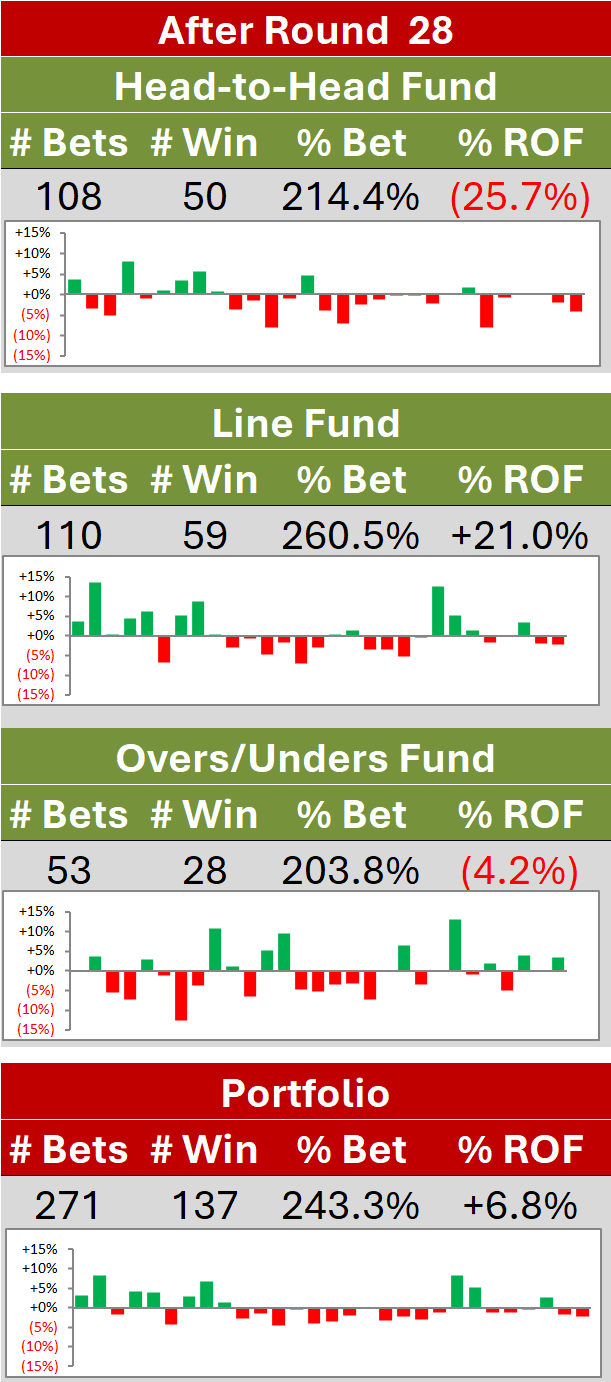2022 : Simulating the Final Ladder After Round 18
/The latest simulations - both Standard and Heretical - suggest that the teams can now be roughly grouped as follows:
Geelong: assured of a Top 8 finish, virtually assured of a Top 4 finish, and 60-70% chances for the Minor Premiership
Melbourne: assured of a Top 8 finish, 80-85% chances for Top 4, and around 20% chances for the Minor Premiership
Brisbane Lions, Fremantle and Sydney: assured of a Top 8 finish, 55-75% chances for Top 4, and around 3-5% chances for the Minor Premiership
Collingwood: virtually assured of a Top 8 finish, 20-30% chances for Top 4, and longshots for the Minor Premiership
Carlton: 85-90% chance of playing Finals, around 15% chance of a Top 4 finish, and extreme longshots for the Minor Premiership
Richmond and Western Bulldogs: 35-45% chances of playing Finals and longshots for a Top 4 finish
St Kilda, Gold Coast, and Port Adelaide: 10-20% chance of playing Finals
Essendon, Hawthorn, Adelaide, GWS, West Coast, and North Melbourne: looking to 2023 and draft picks (with North Melbourne still favourites for the Spoon, and Essendon and Hawthorn still mathematical chances of playing Finals)
(For details about the methodologies I’ve used, see this earlier blog).
LADDER FINISHES
The ladder projections using the Standard methodology (aka “cold” sims) appear on the left, and those using the Heretical methodology (aka “hot” sims) appear on the right.
Looking first just at the Standard Methodology, we see that the range of Expected Wins now runs from 3.0 to 16.5, which has shrunk a little from last week’s range of 2.2 to 15.9 after the Roos’ win. We also see that only 10 teams are now expected to finish with a win percentage above 50%.
The biggest declines in Expected Win tally came this week for Richmond (-1.0), while the biggest increase came for North Melbourne (+0.8).
In terms of Top 8 chances, there were four double-digit changes in estimate, including Western Bulldogs’ +15% points, Collingwood’s +11% points, Gold Coast’s -11% points, and Richmond’s -23% points.
Comparing the results for the Standard and Heretical Methodologies we find:
A slightly larger range of Expected Wins from the Heretical approach (2.9 to 16.7 wins)
A similar ordering of the teams in terms of Expected Wins with only Richmond and Western Bulldogs swapped, and Sydney bumped up a couple of places above Brisbane Lions and Fremantle
Broadly similar estimates for the changes in teams’ Finals chances
TEAM AND POSITION CONCENTRATION
The HHI figures for the most recent simulation replicates appear below, with those from the Standard methodology on the top, and those from the Heretical methodology on the bottom. (For information about the HHI, also see that previous blog linked to earlier).
STANDARD METHODOLOGY
heretical methodology
Another reduction in average uncertainty this week, with decreases for every team except Port Adelaide under the Standard Methodology, and West Coast and North Melbourne under both methodologies.
Both methods suggest that teams are, on average, effectively competing for just under 5 different ladder positions now, and both have most teams competing for between 4 and 6 or 7 positions, the exceptions being Adelaide, GWS, Geelong, West Coast, and North Melbourne.
standard methodology
heretical methodology
These tables also imply a chunky reduction in uncertainty this week, and suggest that there are now 6 to 7 teams effectively competing for each position 4 through 10 on the ladder.
They also have the average ladder position with effectively just under 5 teams likely to fill it, and with most ladder positions effectively expecting anywhere between 4 and 7 teams to be competing for them. The exceptions amongst the ladder positions are 1st, and 15th through 18th.
WINS AND LADDER POSITION
Here’s an updated view of the distribution of team wins and final ladder position, based on the Standard Methodology
If we, again, sum across all the teams, we can see how many wins are most likely for each ladder position, as shown in the chart below.
Last week had quite a dramatic effect on the number of wins most likely to be associated with the team finishing 8th, with 12 wins now a 50% chance (up from 33%), and 13 wins now a 37% chance (down from 56%).
For the team finishing 4th, 15 wins has moved from a 59% probability to 68%, and 14 wins from 32% to 19%. There’s also now a 9% chance that 16 wins will be associated with the team finishing 4th.
This, of course, varies by team, and in the chart below we look at how likely it is that a given team plays Finals if it records a particular number of wins, and how likely that outcome is. In the first chart we use the results from the Standard Methodology, and in the second chart from the Heretical Methodology.
Sydney and Richmond are the only teams with better-than-even chances of making Finals with just 12 wins, while Collingwood and St Kilda (and Gold Coast under the Heretical Methodology) are both worse than 1-in-3 chances with just 12 wins.
Repeating the analysis for finishing in the Top 4.
Geelong is the only team with a better than 2-in-5 chance of finishing 4th when it registers only 14 wins for the season, and St Kilda, Carlton, and Collingwood are all less than 10% chances of finishing 4th if they end the season on 14 wins.
LIKELY IMPORTANCE OF PERCENTAGE
Next, we’ll use the Standard simulations to again investigate the estimated likelihood that any given pair of ladder positions be determined after Round 23 based on percentage.
The simulations are suggesting there is now about a 4-in-9 chance that 8th and 9th on the final home and away ladder will be separated only on the basis of percentage, and a bit less than a 1-in-5 chance that 8th and 10th will also only be separated on that basis.
There remains a slightly better than even-money chance that 4th and 5th will be decided on percentages, and better than a 1-in-3 chance that this will be how the Minor Premiership is decided.
MOST LIKELY SET OF FINALISTS AND TOP 4S
Across the 50,000 replicates from the Standard Methodology, there were 18,308 unique orderings of the 18 teams, and 128 unique orderings of the Top 8.
In the table at right we show the sets of 8 teams that most often finish as the Finalists, in some order.
Two sets of 8 stand out, as you can see, and together appear in over half the replicates. The first of those comprises all of the teams from the current Top 8, and the second swaps in Western Bulldogs (9th on the ladder) for Richmond (8th on the ladder).
What about the Top 4, and this time taking order into account.
There remains quite a lot of uncertainty about this, with even the most common Top 4 - which sees Sydney move from their current 6th spot into 3rd - occurring in only 1-in-25 replicates. The current Top 4 in their current order is only the fifth-most likely final outcome and it appears in fewer than 1-in-40 replicates
Altogether there are 26 Top 4 orderings that appeared in at least 1% of replicates, with Carlton cameoing in one, and Collingwood in five and never higher than 3rd. These 26 orderings - of which there were 863 in total across the entire simulation - together account for only 45% of all replicates.
Geelong finishes as minor premier in all but five of the orderings, and never finishes lower than 2nd. Melbourne appears somewhere in all 26 orderings, Brisbane Lions in 17 of them, Sydney in 16, and Fremantle in 13.
Lastly, let’s look at the Top 2s that came out of the simulations.
The current Top 2 of Geelong and Melbourne dominate, that pair in one order or the other appearing in over 40% of replicates.
The next four orderings all have Geelong in 1st and swap in one of Brisbane Lions, Sydney, Fremantle, or Collingwood for 2nd. Together, they account for just over one-third of all replicates.
There are then four more pairings that occurred in at least 1% of replicates, making in 10 in all for which this was the case. Those 10 represent 86% of all replicates.


